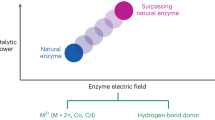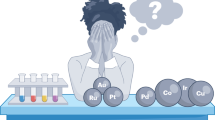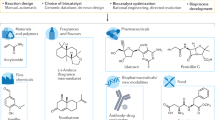Abstract
The technological utility of enzymes can be enhanced greatly by using them in organic solvents rather than their natural aqueous reaction media. Studies over the past 15 years have revealed not only that this change in solvent is feasible, but also that in such seemingly hostile environments enzymes can catalyse reactions impossible in water, become more stable, and exhibit new behaviour such as 'molecular memory'. Of particular importance has been the discovery that enzymatic selectivity, including substrate, stereo-, regio- and chemoselectivity, can be markedly affected, and sometimes even inverted, by the solvent. Enzyme-catalysed reactions in organic solvents, and even in supercritical fluids and the gas phase, have found numerous potential applications, some of which are already commercialized.
This is a preview of subscription content, access via your institution
Access options
Subscribe to this journal
Receive 51 print issues and online access
$199.00 per year
only $3.90 per issue
Buy this article
- Purchase on Springer Link
- Instant access to full article PDF
Prices may be subject to local taxes which are calculated during checkout


Similar content being viewed by others
References
Roberts, S. M., Turner, N. J., Willetts, A. J. & Turner, M. K. Introduction to Biocatalysis Using Enzymes and Microorganisms (Cambridge Univ. Press, New York, 1995).
Faber, K. Biotransformations in Organic Chemistry 4th edn (Springer, Berlin, 2000).
Zaks, A. & Dodds, D. R. Application of biocatalysis and biotransformations to the synthesis of pharmaceuticals. Drug Disc. Today 2, 513–531 ( 1997).
Stinson, S. C. Counting on chiral drugs. Chem. Eng. News 76, 83–96 (1998).
Nelson, D. L. & Cox, M. M. Lehninger Principles of Biochemistry 3rd edn, 192 (Worth, New York, 2000).
Lapanje, S. Physicochemical Aspects of Protein Denaturation Chs 1–3 & 6 (Wiley, New York, 1978).
Griebenow, K. & Klibanov, A. M. On protein denaturation in aqueous-organic mixtures but not in pure organic solvents. J. Am. Chem. Soc. 47, 11695–11700 (1996).
Kuntz, I. D. & Kauzmann, W. Hydration of proteins and polypeptides . Adv. Protein Chem. 28, 239– 345 (1974).
Rupley, J. A. & Careri, G. Protein hydration and function. Adv. Protein Chem. 41, 37–172 (1991).
Fitzpatrick, P. A., Steinmetz, A. C. U., Ringe, D. & Klibanov, A. M. Enzyme crystal structure in a neat organic solvent. Proc. Natl Acad. Sci. USA 90, 8653–8657 (1993).
Yennawar, N. H., Yennawar, H. P. & Farber, G. K. X-ray crystal structure of γ-chymotrypsin in hexane. Biochemistry 33, 7326– 7337 (1994).
Schmitke, J. L., Stern, L. J. & Klibanov, A. M. Crystal structure of subtilisin Carlsberg in anhydrous dioxane and its comparison with those in water and acetonitrile. Proc. Natl Acad. Sci. USA 94, 4250– 4255 (1997).
Zhu, G. et al. X-ray studies on two forms of bovine β-crystals in neat cyclohexane . Biochim. Biophys. Acta 1429, 142– 150 (1998).
Gao, X.-G. et al. Crystal structure of triosephosphate isomerase from Trypanosoma cruzi in hexane. Proc. Natl Acad. Sci. USA 96, 10062–10067 (1999).
Klibanov, A. M. Enzymatic catalysis in anhydrous organic solvents. Trends Biochem. Sci. 14, 141–144 ( 1989).
Koskinen, A. M. P. & Klibanov, A. M. (eds) Enzymatic Reactions in Organic Media (Blackie-Pergamon, London, 1996).
Zaks, A. & Klibanov, A. M. Enzyme-catalyzed processes in organic solvents. Proc. Natl Acad. Sci. USA 82, 3192–3196 (1985).
Klibanov, A. M. Why are enzymes less active in organic solvents than in water? Trends Biotechnol. 15, 97–101 (1997).
Schmitke, J. L., Wescott, C. R. & Klibanov, A. M. The mechanistic dissection of the plunge in enzymatic activity upon transition from water to anhydrous solvents. J. Am. Chem. Soc. 118, 3360–3365 (1996).
Zaks, A. & Klibanov, A. M. Enzymatic catalysis in non-aqueous solvents J. Biol. Chem. 263, 3194– 3201 (1988).
Xu, K. & Klibanov, A. M. pH-control of the catalytic activity of cross-linked enzyme crystals in organic solvents. J. Am. Chem. Soc. 118, 9815–9819 (1996).
Blackwood, A. D., Curran, L. J., Moore, B. D. & Halling, P. J. Organic-phase buffers control biocatalyst activity independent of initial aqueous pH. Biochim. Biophys. Acta 1206, 161–165 (1994).
Griebenow, K. & Klibanov, A. M. Can conformational changes be responsible for solvent and excipient effects on the catalytic behavior of subtilisin Carlsberg in organic solvents? Biotechnol. Bioeng. 53, 351–362 (1997).
Griebenow, K. & Klibanov, A. M. Lyophilization-induced changes in the secondary structure of proteins. Proc. Natl Acad. Sci. USA 92, 10969–10976 ( 1995).
Dabulis, K. & Klibanov, A. M. Dramatic enhancement of enzymatic activity in organic solvents by lyoprotectants. Biotechnol. Bioeng. 41, 566–571 ( 1993).
Dai, L. & Klibanov, A. M. Striking activation of oxidative enzymes suspended in nonaqueous media. Proc. Natl. Acad. Sci. USA 96, 9475–9478 ( 1999).
Khmelnitsky, Y. L., Welch, S. H., Clark, D. S. & Dordick, J. S. Salts dramatically enhance activity of enzymes suspended in organic solvents . J. Am. Chem. Soc. 116, 2647– 2648 (1994).
Russell, A. J. & Klibanov, A. M. Inhibitor-induced enzyme activation in organic solvents. J. Biol. Chem. 263, 11624–11626 (1988).
Broos, J., Sakodinskaya, I. K., Engbersen, J. F. J., Verboom, W. & Reinhoudt, D. N. Large activation of serine proteases by pretreatment with crown ethers. J. Chem. Soc. Chem. Commun. 255–256 (1995).
Okahata, Y. & Mori, T. Lipid-coated enzymes as efficient catalysts in organic media. Trends Biotechnol. 15, 50–54 (1997).
Paradkar, V. M. & Dordick, J. S. Aqueous-like activity of α-chymotrypsin dissolved in nearly anhydrous organic solvents . J. Am. Chem. Soc. 116, 5009– 5010 (1994).
Margolin, A. L. Novel crystalline catalysts. Trends Biotechnol. 14, 223–230 (1996).
Jeffrey, J. A. & Saenger, W. Hydrogen Bonding in Biological Structures (Springer, Berlin, 1994).
Affleck, R., Haynes, C. A. & Clark, D. S. Solvent dielectric effects on protein dynamics. Proc. Natl Acad. Sci. USA 89, 5167– 5170 (1992).
Burke, P. A., Griffin, R. G. & Klibanov, A. M. Solid-state nuclear magnetic resonance investigation of solvent dependence of tyrosyl ring motion in an enzyme. Biotechnol. Bioeng. 42, 87–94 ( 1993).
Zaks, A. & Klibanov, A. M. The effect of water on enzyme action in organic media. J. Biol. Chem. 263, 8017–8021 (1988).
Xu, Z.-F. et al. Transition state stabilization of subtilisins in organic media . Biotechnol. Bioeng. 43, 515– 520 (1994).
Bell, G., Halling, P. J., Moore, B. D., Partridge, J. & Rees, D. G. Biocatalyst behaviour in low-water systems. Trends Biotechnol. 13, 468– 473 (1995).
Almarsson, Ö. & Klibanov, A. M. Remarkable activation of enzymes in nonaqueous media by denaturing organic cosolvents . Biotechnol. Bioeng. 49, 87– 92 (1996).
Ahern, T. J. & Klibanov, A. M. Analysis of processes causing thermal inactivation of enzymes. Methods Biochem. Anal. 33, 91–127 (1987).
Zaks, A. & Klibanov, A. M. Enzymatic catalysis in organic media at 100 °C. Science 224, 1249– 1251 (1984).
Volkin, D. B., Staubli, A., Langer, R. & Klibanov, A. M. Enzyme thermoinactivation in anhydrous organic solvents. Biotechnol. Bioeng. 37, 843–853 (1991).
Garza-Ramos, G., Darszon, A., de Gómez-Puyou, M. T. & Gómez-Puyou, A. Enzyme catalysis in organic solvents with low water content at high temperatures. The ATPase of submitochondrial particles. Biochemistry 29, 751–757 (1990).
Fersht, A. Structure and Mechanism in Protein Science: A Guide to Enzyme Catalysis and Protein Folding (Freeman, New York, 1999).
Wescott, C. R. & Klibanov, A. M. The solvent dependence of enzyme specificity. Biochim. Biophys. Acta 1206, 1–9 (1994).
Carrea, G., Ottolina, G. & Riva, S. Role of solvents in the control of enzyme selectivity in organic media. Trends Biotechnol. 13, 63–70 (1995).
Zaks, A. & Klibanov A. M. Substrate specificity of enzymes in organic solvents vs. water is reversed. J. Am. Chem. Soc. 108, 2767–2768 ( 1986).
Wescott, C. R. & Klibanov, A. M. Solvent variation inverts substrate specificity of an enzyme. J. Am. Chem. Soc. 115, 1629–1631 (1993).
Gaertner, H. & Puigserver, A. Kinetics and specificity of serine proteases in peptide synthesis catalyzed in organic solvents. Eur. J. Biochem. 181, 207–213 (1989).
Ryu, K. & Dordick, J. S. How do organic solvents affect peroxidase structure and function? Biochemistry 31, 2588–2598 (1992).
Wescott, C. R., Noritomi, H. & Klibanov, A. M. Rational control of enzymatic enantioselectivity through solvation thermodynamics. J. Am. Chem. Soc. 118, 10365–10370 (1996).
Ke, T., Wescott, C. R. & Klibanov, A. M. Prediction of the solvent dependence of enzymatic prochiral selectivity by means of structure-based thermodynamic calculations . J. Am. Chem. Soc. 118, 3366– 3374 (1996).
Wu, S.-H., Chu, F.-Y. & Wang, K.-T. Reversible enantioselectivity of enzymatic reactions by media. Bioorg. Med. Chem. Lett. 1, 339– 342 (1991).
Ueji, S. et al. Solvent-induced inversion of enantioselectivity in lipase-catalyzed esterification of 2-phenoxypropionic acids. Biotechnol. Lett. 14, 163–168 (1992).
Tawaki, S. & Klibanov, A. M. Inversion of enzyme enantioselectivity by the solvent. J. Am. Chem. Soc. 114, 1882 –1884 (1992).
Rubio, E., Fernandes-Mayorales, A. & Klibanov, A. M. Effect of the solvent on enzyme regioselectivity . J. Am. Chem. Soc. 113, 695– 696 (1991).
MacManus, D. A. & Vulfson, E. N. Reversal of regioselectivty in the enzymatic acylation of secondary hydroxyl groups mediated by organic solvents. Enzyme Microb. Technol. 20, 225–228 (1997).
Tawaki, S. & Klibanov, A. M. Chemoselectivity of enzymes in anhydrous media is strongly solvent dependent. Biocatalysis 8, 3–19 (1993 ).
Ebert, C., Gardossi, L., Linda, P., Vesnaver, R. & Bosco, M. Influence of organic solvents on enzyme chemoselectivity and their role in enzyme-substrate interaction. Tetrahedron 52, 4867–4876 (1996).
Klibanov, A. M. Enzyme memory—what is remembered and why? Nature 374, 596 (1995).
Ke, T. & Klibanov, A. M. On enzymatic activity in organic solvents as a function of enzyme history. Biotechnol. Bioeng. 57, 746–750 (1998).
Rich, J. O. & Dordick, J. S. Controlling subtilisin activity and selectivity in organic media by imprinting with nucleophilic substrates . J. Am. Chem. Soc. 119, 3245– 3252 (1997).
Stahl, M., Jeppson-Wistrand, U., Mansson, M.-O. & Mosbach, K. Induced stereoselectivity and substrate selectivity of bio-imprinted α-chymotrypsin in anhydrous organic media. J. Am. Chem. Soc. 113, 9366–9368 (1991).
Mingarro, I., González-Navarro, H. & Braco, L. Trapping of different lipase conformers in water-restricted environments. Biochemistry 35, 9935–9944 (1996).
Johnson, D. V. & Griengl, H. Biocatalytic applications of hydroxynitrile lyases. Adv. Biochem. Eng. Biotechnol. 63, 31–55 (1999).
Ke, T. & Klibanov, A. M. Markedly enhancing enzymatic enantioselectivity in organic solvents by forming substrate salts. J. Am. Chem. Soc. 121, 3334–3340 (1999).
Chen, C.-S., Fujimoto, Y., Girdaukas, G. & Sih, C. J. Quantitative analyses of biochemical kinetic resolutions of enantiomers. J. Am. Chem. Soc. 104, 7294–7299 (1982).
Bornscheuer, U. T. & Kazlauskas, R. J. Hydrolases in Organic Synthesis—Regio- and Stereoselective Biotransformations (Wiley, Weinheim, 1999).
Kirchner, G., Scollar, M. P. & Klibanov, A. M. Resolution of racemic mixtures via lipase catalysis in organic solvents. J. Am. Chem. Soc. 107, 7072–7076 (1985).
Carrea, G. & Riva, S. Properties and synthetic applications of enzymes in organic solvents. Angew. Chem. 33, 2226–2254 (2000).
Kitaguchi, H., Fitzpatrick, P. A., Huber, J. E. & Klibanov, A. M. Enzymatic resolution of racemic amines: crucial role of the solvent J. Am. Chem. Soc. 111, 3094–3095 (1989).
Gutman, A. L., Meyer, E., Kalerin, E., Polyak, F. & Sterling, J. Enzymatic resolution of racemic amines in a continuous reactor in organic solvents. Biotechnol. Bioeng. 40 , 760–767 (1992).
Akkara, J. A., Ayyagari, M. S. R. & Bruno, F. F. Enzymatic synthesis and modification of polymers in nonaqueous solvents. Trends Biotechnol. 17, 67–73 (1999).
Chaudhary, A. K., Beckman, E. J. & Russell, A. J. Rational control of polymer molecular weight and dispersity during enzyme-catalyzed polyester synthesis in supercritical fluids . J. Am. Chem. Soc. 117, 3728– 3733 (1995).
Barzana, E., Karel, M. & Klibanov, A. M. A colorimetric method for the enzymatic analysis of gases: the determination of ethanol and formaldehyde vapors using solid alcohol oxidase. Anal. Biochem. 182, 109 –115 (1989).
Marbrouk, P. A. The use of nonaqueous media to prove biochemically significant enzyme intermediates: the generation and stabilization of horseradish peroxidase compound III in neat benzene solution at room temperature. J. Am. Chem. Soc. 117, 2141–2146 (1995).
Michels, P. C., Dordick, J. S. & Clark, D. S. Dipole formation and solvent electrostriction in subtilisin catalysis. J. Am. Chem. Soc. 119, 70–76 (1997).
Barzana, E. Gas phase biosensors. Adv. Biochem. Eng. Biotechnol. 53, 1–15 (1995).
Gill, I. & Vulfson, E. Enzymic catalysis in heterogeneous eutectic mixtures of substrates. Trends Biotechnol. 12, 118–122 (1994).
De Bont, J. A. M. Solvent-tolerant bacteria in biocatalysis. Trends Biotechnol. 16, 493–499 (1998).
Author information
Authors and Affiliations
Corresponding author
Rights and permissions
About this article
Cite this article
Klibanov, A. Improving enzymes by using them in organic solvents. Nature 409, 241–246 (2001). https://doi.org/10.1038/35051719
Issue Date:
DOI: https://doi.org/10.1038/35051719
This article is cited by
-
Biocatalytic transesterification of salmon oil in ionic liquid media to obtain concentrates of omega-3 polyunsaturated fatty acids
European Food Research and Technology (2024)
-
Improving ethanol tolerance of ethyl carbamate hydrolase by diphasic high pressure molecular dynamic simulations
AMB Express (2023)
-
Methanol tolerance upgrading of Proteus mirabilis lipase by machine learning-assisted directed evolution
Systems Microbiology and Biomanufacturing (2023)
-
Bioimprinted Aspergillus niger Lipase Combined with Adsorption Immobilization by Resin and Its Experiment in Catalytic Synthesis of Sucrose-6-acetate
Biotechnology and Bioprocess Engineering (2023)
-
Preparation of hollow spherical covalent organic frameworks via Oswald ripening under ambient conditions for immobilizing enzymes with improved catalytic performance
Nano Research (2023)
Comments
By submitting a comment you agree to abide by our Terms and Community Guidelines. If you find something abusive or that does not comply with our terms or guidelines please flag it as inappropriate.



